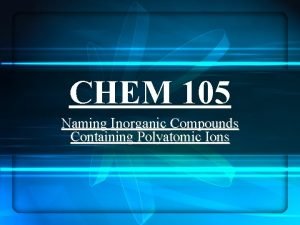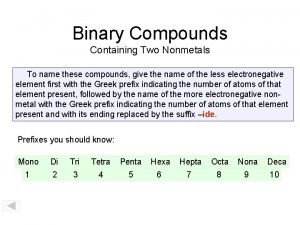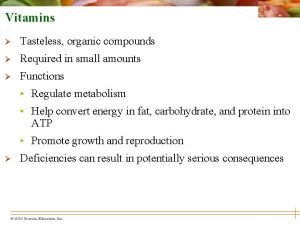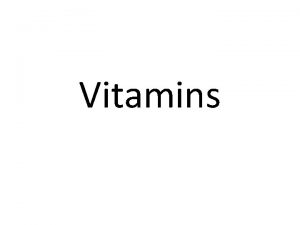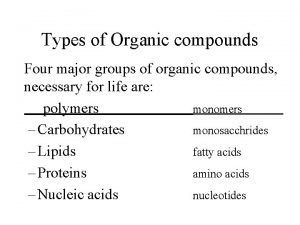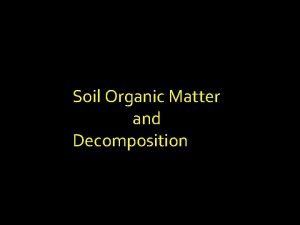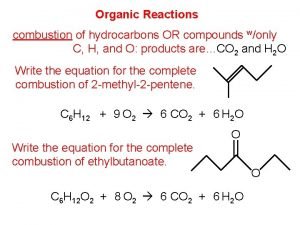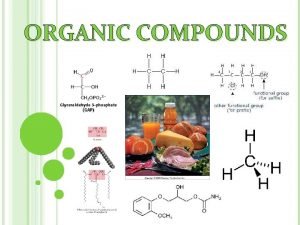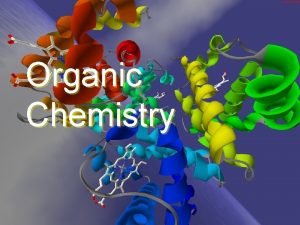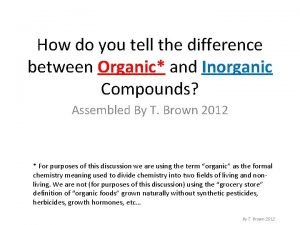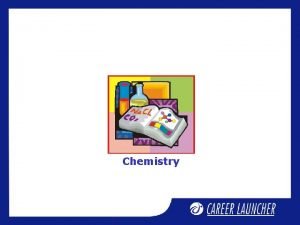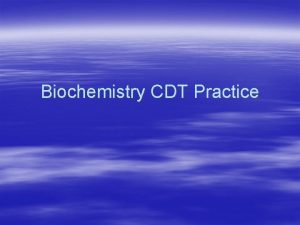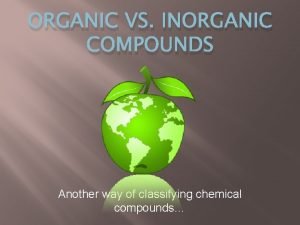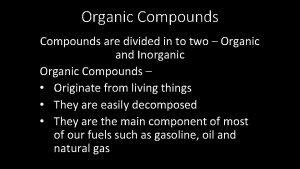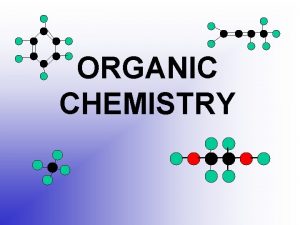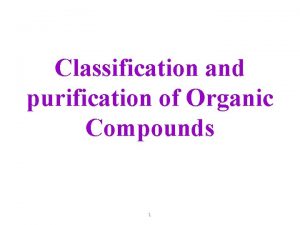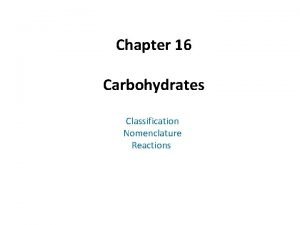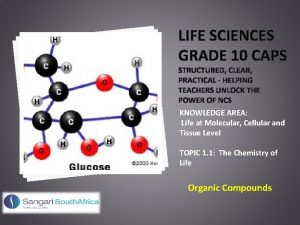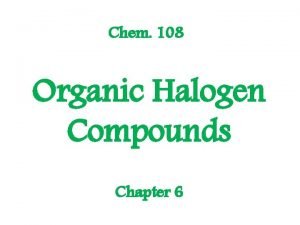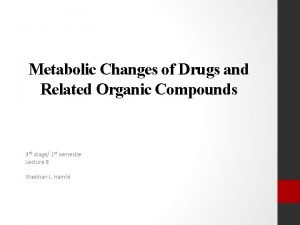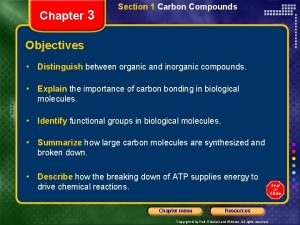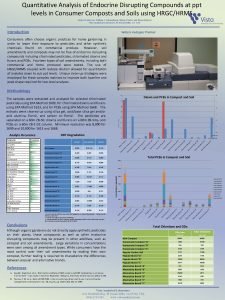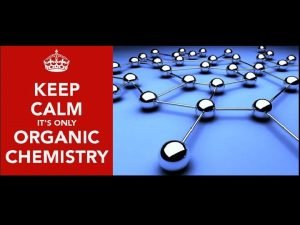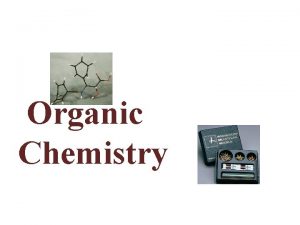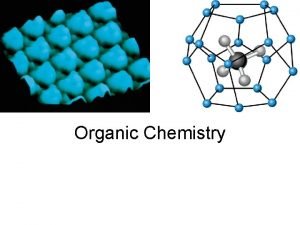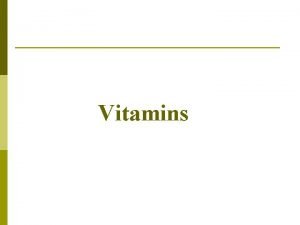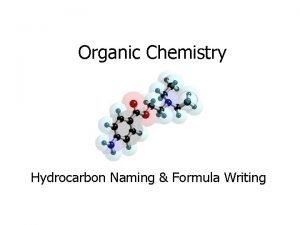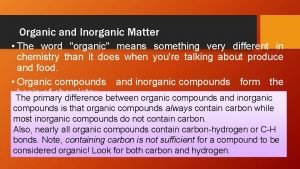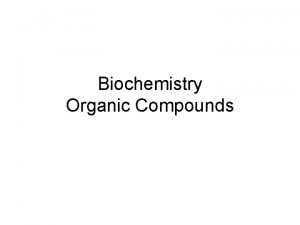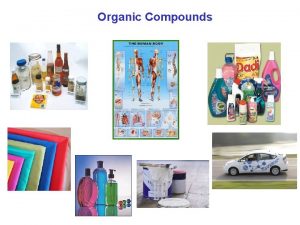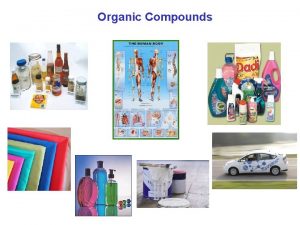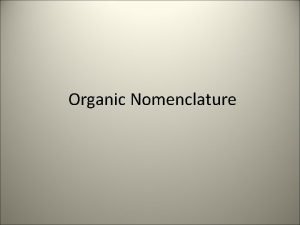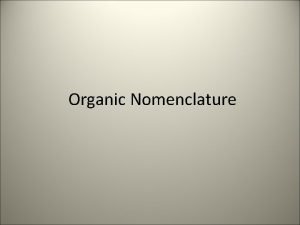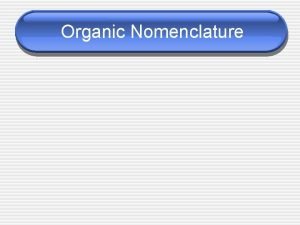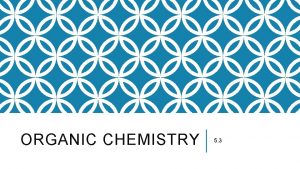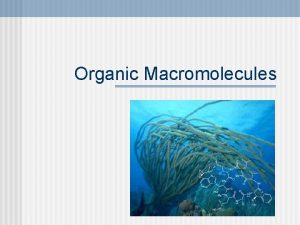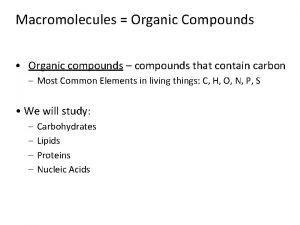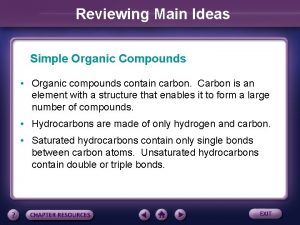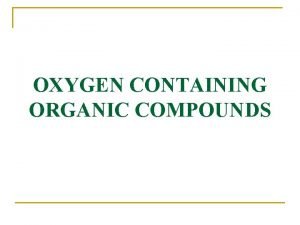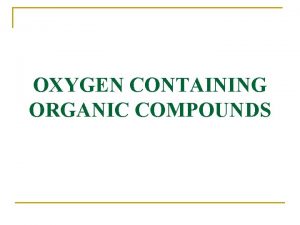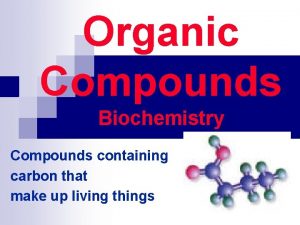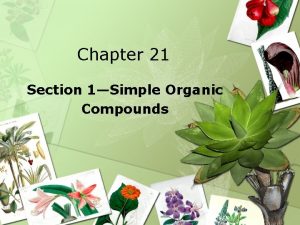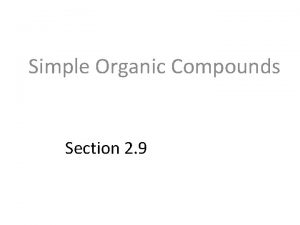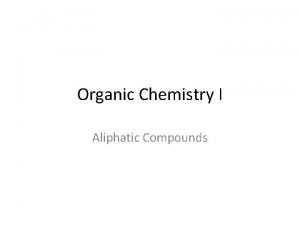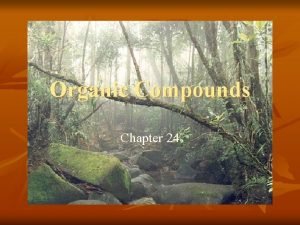Section 1 Simple Organic Compounds Most compounds containing





































- Slides: 37

Section 1 Simple Organic Compounds • Most compounds containing the element carbon are organic compounds. • The others, including carbon dioxide and the carbonates, are considered inorganic.

Section 1 Simple Organic Compounds Bonding • You may wonder why carbon can form so many organic compounds. • The main reason is that a carbon atom has four electrons in its outer energy level. • This means that each carbon atom can form four covalent bonds with atoms of carbon or with other elements.

Section 1 Simple Organic Compounds Bonding • A covalent bond is formed when two atoms share a pair of electrons. • This large number of bonds allows carbon to form many types of compounds ranging from small compounds to complex compounds. • It also can form double and triple bonds as well as single bonds.

Section 1 Simple Organic Compounds Arrangement • Another reason carbon can form so many compounds is that carbon can link together with other carbon atoms in many different arrangements—chains, branched chains, and even rings.

Section 1 Simple Organic Compounds Representing Organic Compounds • There are many ways to represent organic compounds. • Three common ways are the chemical formula, the structural formula, and the space-filling model. • For example, methane can be represented by its chemical formula CH 4.

Section 1 Simple Organic Compounds Representations • Methane can be represented in two other ways. • The structural formula uses lines to show that four hydrogen atoms are bonded to one carbon atom in a methane molecule.

Section 1 Simple Organic Compounds Representations • The second way, the space-filling model, shows a more realistic picture of the relative size and arrangement of the atoms in the molecule.

Section 1 Simple Organic Compounds Hydrocarbons • Methane is a main component of natural gas and is a hydrocarbon. • A compound made up of only carbon and hydrogen atoms is called a hydrocarbon. • Methane and other hydrocarbons produce more than 90 percent of the energy humans use.

Section 1 Simple Organic Compounds Hydrocarbons • Another hydrocarbon used as fuel is propane. • Propane's structural formula and space-filling model are shown.

Section 1 Simple Organic Compounds Hydrocarbon Lengths • Hydrocarbon chains come in many lengths. • The root of the hydrocarbon’s name tells you how many carbon atoms are in the chain. • This table lists the roots for some hydrocarbons.

Section 1 Simple Organic Compounds Hydrocarbon Lengths • This figure shows a graph of the boiling points of some hydrocarbons. • Notice the relationship between boiling points and the addition of carbon atoms.

Section 1 Simple Organic Compounds Bonding in Hydrocarbons • An easy way to remember what type of bond a hydrocarbon has is to look at the last three letters. • Compounds ending with -ane have a single bond; the ending -ene indicates a double bond, and -yne indicates a triple bond.

Section 1 Simple Organic Compounds Single Bonds • Hydrocarbons that contain only single bonds are called saturated hydrocarbons. • The table lists four saturated hydrocarbons. • Notice how each carbon atom appears to be a link in a chain connected by single covalent bonds.

Section 1 Simple Organic Compounds Multiple Bonds • Hydrocarbons, such as ethene and ethyne, that contain at least one double or triple bond are called unsaturated hydrocarbons.

Section 1 Simple Organic Compounds Multiple Bonds • Ethylene is another name for the hydrocarbon ethene, (C 2 H 4). • This contains one double bone in which two carbon atoms share two pairs of electrons. • The hydrocarbon ethyne (C 2 H 2) contains a triple bond in which three pairs of electrons are shared.

Section 1 Simple Organic Compounds Structural Isomers • The chemical formula of pentane is C 5 H 12. • Two other hydrocarbon called isopentane and neopentane have exactly the same chemical formula. • How can this be?

Section 1 Simple Organic Compounds Structural Isomers • The answer lies in the arrangement of the five carbon atoms. • In a molecule of pentane, the carbon atoms form a continuous chain.

Section 1 Simple Organic Compounds Structural Isomers • The carbon chain of iospentane has one branch and the chain of neopentane has two branches.

Section 1 Simple Organic Compounds Structural Isomers • Pentane, isopentane, and neopentane are isomers. • Isomers are compounds that have identical chemical formulas but different molecular structures and shapes. Click image to play movie

Section 1 Simple Organic Compounds Properties of Isomers • The arrangement of carbon atoms in each compound changes the shape of the molecule, and very often affects its physical properties. • Generally, melting points and boiling points are lowered as the amount of branching in an isomer increases.

Section 1 Simple Organic Compounds Properties of Isomers • You can see this pattern in the table.

Section 1 Simple Organic Compounds Properties of Isomers • You may have noticed that the melting point of neopentane does not follow the general trend. • Its higher melting point is due to its symmetry and globular shape.

Section 1 Simple Organic Compounds Other Isomers • There are many other kinds of isomers. • In unsaturated hydrocarbons, the double and triple bonds can be located in different places in a carbon chain. • For example, in this butene isomer (called 1 -butene), the double bond is between the first and second carbon atoms.

Section 1 Simple Organic Compounds Other Isomers • In these butene isomers, the double bond is between the second and third carbons. • Notice that there are two ways that the chain can bend when the double bond is in this location.

Section 1 Simple Organic Compounds Other Isomers • Some isomers differ only slightly in how their atoms are arranged in space. • Such isomers form what is often called right- and lefthanded molecules, like mirror images. • Two such isomers may have nearly identical physical and chemical properties.

Section 1 Simple Organic Compounds Carbon Rings • Carbon chains can also form rings. These rings are often referred to as cyclic compounds • Carbon rings are indicated by the prefix cyclo-, which means circular. • Three cyclic compounds�cyclopropane, cyclopentene, and cycloctyne�are shown here.

Section 1 Simple Organic Compounds Benzene • Look at a model of benzene, C 6 H 6, and its structural formula. • As you can see, the benzene molecule has six carbon atoms bonded into a ring with alternating double and single bonds.

Section 1 Simple Organic Compounds Benzene • The electrons shown as alternating double and single bonds that form the ring are shared by all six carbon atoms in the ring.

Section 1 Simple Organic Compounds Benzene • This equal sharing of electrons is represented by the special benzene symbol—a circle in a hexagon. • Many compounds contain this stable ring structure. • The stable ring acts as a framework upon which new molecules can be built.

Section 1 Simple Organic Compounds Fused Rings • Benzene rings sometimes fuse together. • One type of moth crystal is made of naphthalene (NAF thuh leen), which is two fused benzene rings.

Section 1 Simple Organic Compounds Fused Rings • Many known compounds contain three or more rings fused together. • Tetracycline (teh truh SI kleen) antibiotics are based on a fused ring system containing four fused rings.

Section 1 Section Check Question 1 What element must a compound contain in order to be considered an organic compound? A. carbon B. nitrogen C. oxygen D. hydrogen

Section 1 Section Check Answer The answer is A. Most compounds containing carbon are organic compounds.

Section 1 Section Check Question 2 Which is a hydrocarbon? A. propane B. ethanol C. acetic acid D. mercaptan

Section 1 Section Check Answer Propane is a hydrocarbon, made up of only carbon and hydrogen atoms.

Section 1 Section Check Question 3 Hydrocarbons containing only single-bonded carbon atoms are called _____.

Section 1 Section Check Answer They are called saturated hydrocarbons. “Saturated” in this term means the compound holds as many hydrogen atoms as possible.
 Ionic compounds containing polyatomic ions
Ionic compounds containing polyatomic ions What is the term for a compound containing two nonmetals?
What is the term for a compound containing two nonmetals? Headless compound
Headless compound Ionic compounds containing transition metals
Ionic compounds containing transition metals Vitamins are tasteless organic compounds
Vitamins are tasteless organic compounds Vitamin flowchart
Vitamin flowchart Four types of organic compound
Four types of organic compound Decomposition of organic matter equation
Decomposition of organic matter equation Charring test of organic and inorganic compounds
Charring test of organic and inorganic compounds Combustion of organic substances
Combustion of organic substances Hagfish slime macromolecule
Hagfish slime macromolecule All organic compounds must contain the element
All organic compounds must contain the element Organic compounds must contain
Organic compounds must contain Iupac practice sheet
Iupac practice sheet Introduction to organic chemistry
Introduction to organic chemistry Organic vs inorganic compounds
Organic vs inorganic compounds Purification and characterization of organic compounds
Purification and characterization of organic compounds Organic compounds such as proteins and starches are too
Organic compounds such as proteins and starches are too Organic vs inorganic compounds
Organic vs inorganic compounds What is the classification of organic compounds
What is the classification of organic compounds Group of carbon
Group of carbon Principle of simple distillation
Principle of simple distillation Pyranoses
Pyranoses Organic compounds grade 10 life science
Organic compounds grade 10 life science Organic halogen compounds
Organic halogen compounds Hemoragea
Hemoragea Metabolic changes of drugs and related organic compounds
Metabolic changes of drugs and related organic compounds All organic compounds contain carbon and ________.
All organic compounds contain carbon and ________. Families of organic compounds
Families of organic compounds Quantitative analysis of organic compounds ppt
Quantitative analysis of organic compounds ppt Type of organic compounds
Type of organic compounds Sextext of electrons
Sextext of electrons Hydrocarbons class 11
Hydrocarbons class 11 Vitamins are organic compounds that
Vitamins are organic compounds that What is a nucleotide
What is a nucleotide Number of organic compounds
Number of organic compounds Site:slidetodoc.com
Site:slidetodoc.com Four types of organic compounds
Four types of organic compounds
